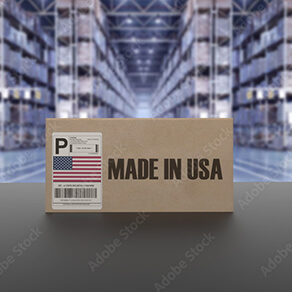
Is “Made in America” the Right Model for Your Business?
Customer preference for American-made products isn’t new.
After strained supply chains due to the COVID-19 pandemic, the decision to move from overseas suppliers to domestic factories may have already been made for you.
But higher labor rates and overhead costs may cause some “homegrown” products to be more expensive than foreign-sourced products. Will your purchasers balk at the higher price tag?
As 2023 starts, manufacturers and distributors should weigh whether a Made-in-the-USA strategy will help attract customers. Here are some angles to consider to position your business accordingly.
What Are the Rules?
To claim a product is “Made in the USA,” you must comply with strict regulations enacted by the Federal Trade Commission (FTC). Under the rules, final assembly must take place on U.S. soil and the majority of total manufacturing costs must be spent on U.S. parts and processing. Complex labeling standards may also apply if an American flag or map is used on packaging to imply the country of origin.
A company can make a qualified claim when a product is made in several countries, however. For example, it may specify the percentage of a product’s domestic content or label a product as “Assembled in the USA” instead.
Compliance with these rules is essential when starting new advertising programs or repackaging with the “Made in the USA” label. False claims are likely to attract an FTC investigation, which could lead to enforcement actions and negative publicity. Violators also may need to modify packaging to comply with the FTC regulations, which can be another costly expenditure.
What Are the Benefits?
Deciding to have your product “Made in the USA” will undoubtedly benefit domestic manufacturing. Prepare by investing staff, inventory and equipment to meet the increasing demand for domestic-made products. Remind your customers about the benefits of using domestic manufacturers. This includes:
Less expensive and more reliable shipping. Tariffs and high shipping costs can make overseas production cost prohibitive. And volatile foreign political environments may prevent products from shipping on time, leading to production delays.
Domestic labor force. People feel patriotic when they support the U.S. economy and create jobs for American workers. They also want to know that factory workers aren’t subjected to unsafe conditions, low wages or other forms of exploitation that the U.S. Department of Labor and domestic labor unions protect against.
Limiting business risks. Intellectual property theft and devaluation of the U.S. dollar are just some of the risks companies face when they outsource production to other countries. Additionally, important instructions — such as product specifications or shipping terms — may be lost in translation when communicating with foreign suppliers.
Product safety. News stories about contaminated plastic and pet food products from China have led to recalls, illnesses and even deaths. Products made under the scrutiny of the U.S. Food and Drug Administration and Departments of Commerce and Agriculture are typically held to higher quality standards than many foreign-made products. Safer materials and products give manufacturers peace of mind that they’re not exposing end-users to unsafe products — and themselves to liability claims.
Environmental effects. The U.S. Environmental Protection Agency also requires manufacturers to adhere to strict environmental standards that limit emissions and pollutants. Other countries, including China and India, are making huge carbon footprints today that will harm the environment for many years.
Is It Time?
For manufacturers that have used overseas suppliers, deciding when and whether to return to U.S. factories and suppliers can be a tough decision. If you do make the move, consider implementing a marketing campaign that positions your products as American-made, whether you sell to businesses or consumers.
